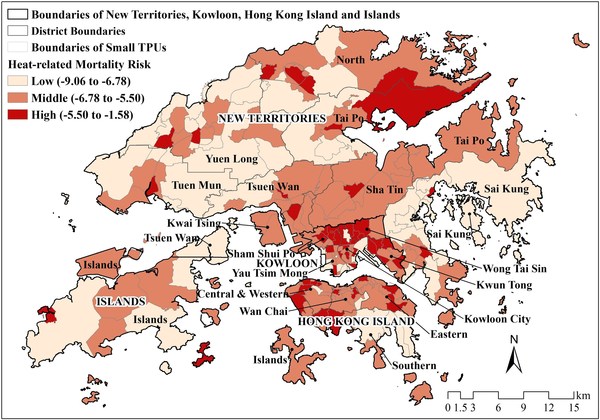Study: Heat death risk intervention tailoring should not stop at city level
SUZHOU,China,Sept. 7,2021 -- An innovative study by researchers at Xi'an Jiaotong-Liverpool University,Harvard University and City University of Hong Kong sheds light on how risk factors for heat-related death can vary at city,city-region and neighbourhood levels.

Map of heat-related mortality risk,Hong Kong
In urban planning,heat mitigation and climate change strategies too often use a top-down approach that does not effectively address specific conditions at all these levels,says Dr Jinglu Song of XJTLU.
After analysing factors contributing to heat-related death at different spatial scales,the study found a localised,spatial scale approach is more effective. (Spatial scale categorises the size of a space in which something occurs.) The research considered factors that include age,education,socioeconomic status,workplace,birthplace and environmental variables.
Beyond top-down interventions
Extreme heat is a leading cause of weather-related human mortality throughout much of the world,posing a significant burden when developing healthy and sustainable cities. The study provides a framework for professionals such as geographers,urban planners,policymakers,environmental scientists and epidemiologists to better understand the spatial-scale dependent risk factors of heat-related mortality,Dr Song says.
"Most cities in the Chinese mainland have a problem similar to Hong Kong—they have developed top-down interventions," Dr Song says. "They don't consider much of a hierarchical strategy and rarely include site-specific action plans. Some measures or interventions should not only be the responsibility of the provincial or municipal governments. They also need to consider community-oriented adaptive strategies."
Measuring risk factors
Risks for heat-related death come from factors that might be only obvious at specific sites.
The researchers found thatage andsocioeconomic status significantly influence risk across a city,Dr Song explains.
Other risk factors exhibit more localised contributions to heat-related mortality,such as thermal environment and low income. Those findings suggest each region needs to be assessed individually to achieve answers that address local conditions,Dr Song says.
The study,'Spatial-scale dependent risk factors of heat-related mortality: A multiscale geographically weighted regression analysis',was published in the Elsevier journal Sustainable Cities and Society.